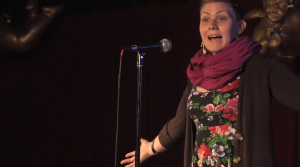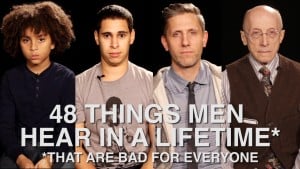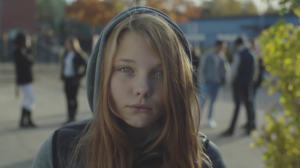Originally published on Adios Barbie and republished here with their permission.

Two students in front of a computer, smiling; one is seated in a wheelchair.
The first time I formally learned about mental illnesses and disabilities was in my high school health class.
Along with topics like pregnancy and a healthy diet, we also touched on eating disorders, schizophrenia, addiction, and physical disabilities.
I use the phrase “touched on” deliberately – because while these topics were mentioned, we never really talked about them.
We watched outdated videos with singular, stereotypical (mainly white, cis, middle-class) examples of individuals living with or affected by mental illnesses and various physical disabilities. We read definitions and biomedical criteria of diagnoses in textbooks filled with glossy photographs of the same stereotypical depictions as the videos.
It took me years to merge these classroom images with the lived experiences of people I knew.
As more and more schools recognize the importance of incorporating social justice topics and consent into the classroom, it’s important to recognize how the US education system has so far not only failed to contest ableism and mental health stigma, but also fails to challenge schools’ reinforcing these forms of oppression.
The US education system (at all levels) has helped to create and maintain mainstream (mis)understandings of mental illness and disability. In this way, it has limited disabled and mentally ill folks’ access to educational and labor opportunities.
The school system’s failure to be inclusive and educate students about mental illness and disability has contributed to stigma and stereotypes, further causing harm.
To some degree, radical changes within education (for example, a greater prioritization of mental health services) are needed to fully address the role of schools in the fight against ableism and mental health stigma. But even without structural and policy changes, there are ways schools can start to combat these issues.
Here are just three suggestions how.
1. Integrate Mental Health and Disability into School Curriculums
While some states and schools may cover disability and mental health within specific courses or units, like my high school did, schools should integrate these topics continuously.
How this would look in practice would largely depend on the subject matter.
For example, classrooms can integrate books written by, about, and depicting disabled folks. Political science and history classes can and should discuss the historical and contemporary reality of violence against disabled people and individuals with mental illnesses, such as police violence against mentally ill individuals. Relatedly, classes could discuss various social justice activist movements like the Section 504 Sit-In of the 1970s.
However schools may choose to do it, the narratives and – again – lived experiences of disabled folks and individuals with mental illnesses need to be integrated into the overall curriculum.
It isn’t enough to mention the American Disabilities Act or to showcase one narrative as inspiration porn. Schools should seek to destigmatize disability and mental illness through continued discussions and education.
2. Support the Voices of Disability and Mental Health Justice Activists
It’s important for non-disabled students to contextualize disabilities and mental illness as reality. By bringing in individuals to hold discussions about their work for disability and mental health justice, these movements become much more real.
For disabled students and those with mental illnesses, being able to hear about others’ experiences can be incredibly validating and empowering. It’s a reminder that they’re not alone.
For able-bodied and neurotypical students, understanding real experiences of disability and mental illness helps dismantle stereotypes and combat stigma.
I am by no means advocating for an inspiration-porn type of assembly, but rather a chance for children (and adults) to learn about the work (and especially activism) of disabled individuals and those with mental illnesses, especially if students have been studying their particular work in the classroom.
This will also help schools fight stereotypes regarding mental illness and disability. Having a person talk about invisible disabilities can broaden students’ understanding of disability and help validate the narratives of specific students. Similarly, engaging in a discussion about eating disorders with people of color can help dismantle the idea that eating disorders only affect white women.
3. Redefine Accommodations
Although mental illnesses are recognized under Title II of the American Disabilities Act, most schools’ accommodations largely ignore mental illnesses. This reflects the general attitude and understanding of mental illness in our society.
Historically, people with mental illnesses have been excluded and institutionalized (and then subsequently deinstitutionalized without proper support systems or resources). Mental illness continues to be misunderstood and stigmatized within larger society and this influences how schools interact with students with mental illnesses.
Moreover, mental health services are largely underfunded and understaffed in schools, meaning that workers without mental health training may be reviewing accommodation cases involving mental illnesses.
Of course, having access to technology or extra time during a test are very important accommodations, but for someone with a mental illness, this may not be enough. Individuals with mental illnesses may instead need greater flexibility in terms of absences or participation-based grading.
In choosing to expand the types of accommodations available, schools can both make their classrooms accessible and help contest the boundaries of disability and accessibility.
***
This is not a complete list. The task of destigmatizing mental illness and ending ableism is much more complex than what I’ve suggested here.
However, by starting to integrate, validate, and support disabled people and people with mental illnesses through our education system, we can start to combat saneism and ableism more cohesively as a society.
* I use the term “disabled person/folks” to respect various disability activists’ critique of person-first language (as well as the tendency of able-bodied individuals to impose person-first language onto disabled people), but recognize and respect individuals who identify with and use person-first language.
[do_widget id=’text-101′]
Kira Rakova is an undergraduate student activist at the City College of New York studying international studies, communications, and anthropology. She is part of various community-based organizations, including the Student Mental Health Initiative, Body-positive Empowerment & Acceptance Movement (BEAM), and the Gender Resource Center Campaign. Her passions and interests include eating disorder justice, destigmatization of mental health, gender justice, and community empowerment.
Search our 3000+ articles!
Read our articles about:
Our online racial justice training
Used by hundreds of universities, non-profits, and businesses.
Click to learn more




















